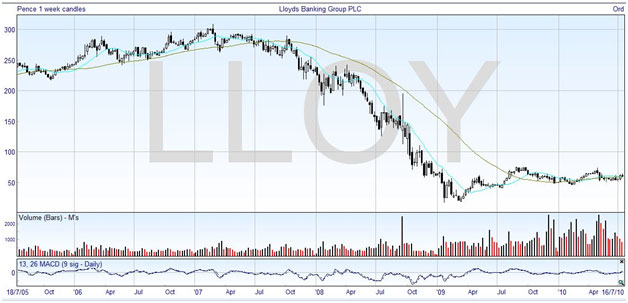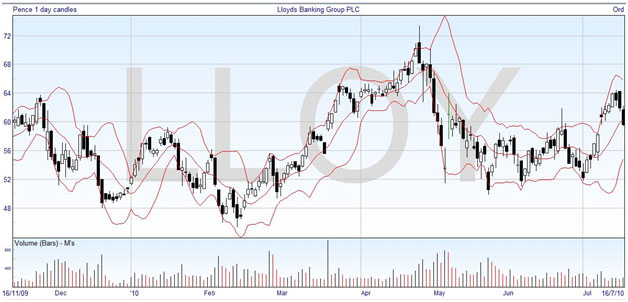Spread Bet Lloyds Banking Group
Fundamentals
There can hardly be a person who has not heard of Lloyds Bank. In its latest incarnation it is a combination of Lloyds TSB (a prior combination of Lloyds and the Trustee Savings Bank) and the Halifax banking group HBOS. As such, it is now the largest ever UK bank, dealing with 25% of all savings accounts and more than 30% of UK mortgages.
However, recent years have been troubling for the banking industry, which means that nearly half of the group is currently owned by the government. The banking group’s fortunes are closely tied to the UK economy and the bank could see lending increase with falling bad debts if momentum continues to build as expected.
Lloyds is split into four divisions – retail, wholesale, insurance, and ‘wealth & international’. The titles are fairly self-explanatory. Retail covers the High Street banking area, with personal accounts, credit cards, and mortgages. Wholesale is commercial, or corporate banking. Insurance covers the general divisions of pensions, life insurance, and other insurance, while wealth & international is concerned with private banking for richer customers.
While the last couple of years have been interesting ones for the banking industry, most have survived relatively unscathed, and a bank the size of Lloyds, after suitable rescue funding, can be assumed to continue functioning in a profitable manner. A recent decline in share prices seems to be over, and values are picking up again. It might sound cynical to say that we are back to “business as usual”, but effectively that is what the bailout has permitted.
Traditionally, the banking industry was considered to be a very stable business, and government guarantees allow consumers to be confident that their money is safe in this style of investment. There are several other types of investment available, most of which have the promise of better returns than simply putting money away in a savings account, but there will always be a market for the convenience of the high street bank accounts. The growing popularity of Internet banking should pose little threat to the convenience of a local financial institution.
The outlook for Lloyds Bank is for steady and unexciting growth, and this is not a share for those who want to gamble for high returns. The bank’s fortunes are closely tied to the UK economy with the bank focusing on a quality loan book, in which more than half its lending, £303 billion or 60%, is secured against property. However, spread betting on Lloyds Banking Group is a different prospect because of the possibility to gear up any profits. If you look at the chart in recent months, you will see that it is not unusual to have moves of £2.50 or £3 in the share price in a day, and this presents a good opportunity for leverage style trading, such as spread betting or contracts for difference.
When you’re looking at making the short term profits from price moves over a period of hours or days, then you need to become conversant with technical analysis and apply it to analyze the mood of the market to help you anticipate which way the price will move. Technical analysis can give you valuable information about whether a price is overextended and likely to come down, or whether it is currently good value and due for an increase. If you want to spread bet on Lloyds Banking Group, then you should follow the charts for a few weeks so that you can understand the size and types of moves to expect, before committing serious money to the enterprise.
 |
Trading or spread betting Lloyds Banking Group requires some insight into the involvement of the government in the rescue, and the involvement of the group in the riskier investments. The chart shows clearly how the price has stabilized since the crash, yet how the trading volume has increased greatly at the same time.
Lloyds Banking Group was formed from Lloyds TSB and HBOS merging in 2009. The previous merger back in 1995 was between Lloyds Bank and Trustee Savings Bank (TSB). As a result of this, Lloyds Banking Group is the largest ever UK bank.
The UK government still owns over 40% of LBG, and the rest is privately owned by shareholders from both Lloyds TSB and HBOS. It’s been estimated that LBG have about one-third of all mortgages in Britain, and have one-quarter of the savings. If LBG sneezes, Britain catches a cold.
Looking at the trading opportunities, here is a daily chart of recent times -:
 |
It’s interesting to note that although the weekly chart looks as if all major price action ceased over a year ago, there is still plenty of movement on a daily level which makes this a suitable stock to follow and profit from spread betting.
The stock has been ranging for a few months with no overriding direction. This is despite the increasingly optimistic outlook, with inflation under control, growing manufacturing, and an expected profit for the Group this year. With the Bank of England’s key lending rate at 0.5%, times are pretty good for financial lenders, who can offer attractive rates which are likely to be repaid and still make a profit. The other advantage in the UK compared with other countries’ banking systems is the way that the mortgage system works.
Any fixed interest mortgages tend to be short term, and this means that the rate is reset more often than with other loans. With low base rates, this puts customers into a better situation, reducing their commitments. Lloyds have about 60% of their lending focused in the mortgage sector, which is much larger than the banking sector as a whole. A typical domestic UK bank probably has about 45% of its lending in the mortgage market.
It is Lloyds’ intention to sell off assets in the next four years to help with repaying the government investment. This includes the Cheltenham and Gloucester brand, the TSB brand particularly in Scotland, and a group called Intelligent Finance, which is a UK bank which is currently under the Bank of Scotland division. Unfortunately last year (2012) Lloyds (LLOY) was also hit by the payment protection insurance (PPI) scandal and the bank has set aside £5.3 billion to meet the cost of repayments.
Although artificially propped up by the government so recently, the banking sector has now turned around and looking like a good play for investors as well as being a responsive stock for traders.
Spread Betting on Lloyds Banking Group
If you want to spread bet on Lloyds Banking Group, you have several choices on a major share like this, such as a daily rolling bet or futures based bets. Considering first the rolling daily bets, these are the ones where your spread betting company automatically closes your bet in the evening and simultaneously opens a new one for the next day, which can result in a charge to your account for interest. Generally, charges are small and insignificant if you do not intend staying in the bet more than a couple of weeks. The current price quoted by IG Index is 35.749 – 35.821.
If you think that the shares of Lloyds will be going up, then you would place a long or buy bet, which is at the higher price quoted. Regardless of the value quoted to you, you can choose the size of bet, so you may decide to bet £25 per point.
Say that Lloyds continues to climb, and you decide to cash in your bet and take your profit when the quote gets up to 36.631 – 36.703. To calculate how much you won, first you must work out how many points the price moved in your favour. The bet was placed at 35.821, and you closed it at the selling price of 36.631. Taking one from the other, you have a difference of 0.810 points (pence). You then multiply this by your stake of £25 per point to find a profit of £20.25.
Any time that you enter financial trading, you need to consider the downside, what happens if it does not go in your direction. One very important lesson is that you should minimize your losses, by closing your bet as soon as you realize it is not going to be profitable. Say the price went to 35.486 – 35.558, and you closed your bet. The bet originally went on at 35.821, and this time the closing price was 35.486. That means you lost 0.335 points. That amounts to a loss of £8.37.
Now to look at a futures style bet. The spread betting quote for a bet for 7 months time is 36.524 – 36.990. As this is higher than the daily price, it tells us that the market is expecting the shares to increase in value. The spread, the difference between the buying and selling prices, is larger which is to be expected, as there are no daily charges with a futures style bet.
Say this time you want to bet on the shares going down, you could place a sell bet at 36.524 for £100 per point. If it dropped to 34.236 – 34.652, you could close your bet and collect your winnings. The bet went on at 36.524, and was closed at 34.652. The difference is 1.872, which means you won £187.20.
Once again, you must consider the downside and be prepared to exit your trade if it turns against you. Say the price went up to 36.796 – 36.860, and you closed your bet. You have lost 36.860-36.524, which is 0.336 points. This amounts to £33.60.


Join the discussion